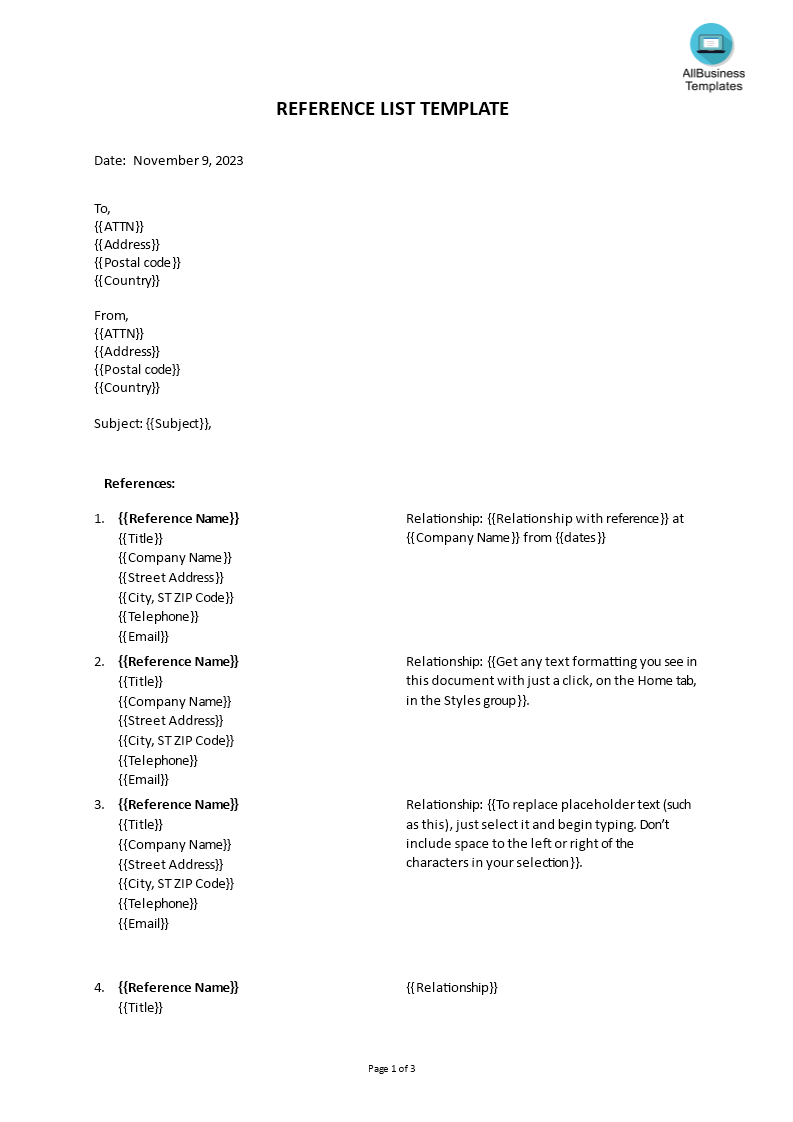Reference List template
Sponsored Link免费模板 保存,填空,打印,三步搞定!

Download Reference List template
微软的词 (.docx)免费文件转换
- 本文档已通过专业认证
- 100%可定制
- 这是一个数字下载 (66.67 kB)
- 语: English
Sponsored Link
How do I make a reference list in Word? What should be on a reference list? We have created a template that will help you create an organized reference list. It includes fields for the author's name and title, year of publication, publisher, and page numbers. It also provides a space for notes so you can keep track of any additional information.
A reference list is important for several reasons, depending on the context in which it is used, whether in academic, professional, or research settings. Here are the key reasons why a reference list is important:
- Credibility: A reference list provides credibility and integrity to your work. It demonstrates that you have conducted research and used authoritative sources to support your claims, arguments, or findings. It shows that your work is not based solely on personal opinions but is rooted in existing knowledge and scholarship.
- Avoiding Plagiarism: Properly citing and listing your sources in a reference list is a fundamental step in avoiding plagiarism. Plagiarism is a serious ethical violation in academia and the professional world, and a reference list helps attribute credit to the original authors and creators of the content you use.
- Verification and Replication: A reference list allows readers or researchers to verify and replicate your work. They can access the same sources you used to review the information, evaluate the quality of the sources, and potentially build upon your research.
- Transparency: It promotes transparency by showing readers where your information and data come from. It helps readers understand the context of your work and the sources that informed your research.
- Supporting Claims: When you make claims or arguments in your writing, a reference list provides the evidence and support for those claims. It strengthens your arguments and makes your work more persuasive.
- Academic and Professional Integrity: In academic and professional settings, providing a reference list is a fundamental aspect of integrity. It showcases your commitment to academic honesty and responsible research practices.
- Legal Protection: A reference list can also provide legal protection. If you are using copyrighted materials, proper citation and listing of sources can help demonstrate that you are using the material in compliance with copyright laws.
- Acknowledging Intellectual Contributions: A reference list is a way to acknowledge the intellectual contributions of others. It honors the work and ideas of researchers, authors, and scholars whose work you have used.
- Building a Knowledge Base: A well-organized reference list contributes to the collective knowledge base by directing others to valuable sources of information. It aids in the dissemination of knowledge and encourages others to explore and engage with the sources you've referenced.
- Professionalism: In professional contexts, such as job applications and business reports, a reference list reflects your professionalism. It demonstrates that you are diligent in providing accurate and well-documented information.
- Compliance with Style Guides: Many academic and professional fields have specific style guides that dictate how references should be cited and formatted. A well-constructed reference list ensures compliance with these style guides, which is often a requirement in such contexts.
In summary, a reference list is essential for maintaining academic and professional integrity, providing credibility to your work, and ensuring proper attribution to the sources you've used. It serves as a vital tool for readers, researchers, and the broader academic and professional communities to verify, build upon, and engage with your work.
When writing a thesis, research paper, news article, etc, it's common that you need to quote someone else, because they have paraphrased what you are trying to say in a suitable or memorable way. When you cite someone else’s ideas, research conclusions, statistics, or unique information, it's important that you always cite the source and give its authors credit for their ideas and work. If use the same
words as the original author (or authors) it is called a direct quote and you must communicate this to the readers.
If you fail to do so, it can be considered plagiarism. Quoting and adding a reference to the source is in principle the same as if it comes from a book, website academic article, newspaper, etc. This reference list is a good example of how you professionally cite and add references in your work.
Reference List format:
- {{Reference Name}}
- {{Title}}
- {{Company Name}}
- {{Street Address}}
- {{City, ST ZIP Code}}
- {{Telephone}}
- {{Email}} Relationship: {{Relationship with reference}} at {{Company Name}} from {{dates}}
- (oten written fully or in parts in italics)
After downloading this sample reference list you can easily modify the style, typography, details, and appearance of your list and directly start filling in the blanks.
Download this sample references list format now.
DISCLAIMER
Nothing on this site shall be considered legal advice and no attorney-client relationship is established.
发表评论。 如果您有任何问题或意见,请随时在下面发布
相关文件
Sponsored Link

